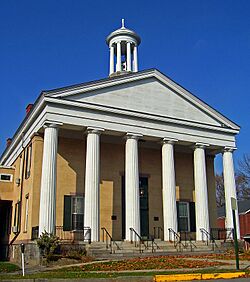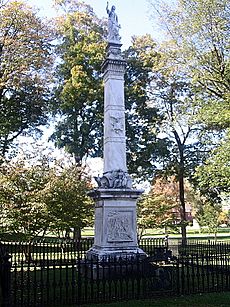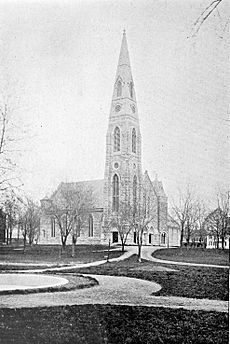Goshen (village), New York facts for kids
Quick facts for kids
Goshen
|
|
|---|---|

1841 Courthouse
|
|
| Country | United States |
| State | New York |
| County | Orange |
| Town | Goshen |
| Settled | 1714 |
| Incorporated | 1809 |
| Area | |
| • Total | 3.32 sq mi (8.60 km2) |
| • Land | 3.32 sq mi (8.60 km2) |
| • Water | 0.00 sq mi (0.00 km2) 0% |
| Elevation | 440 ft (130 m) |
| Population
(2020)
|
|
| • Total | 5,777 |
| • Density | 1,740.06/sq mi (671.77/km2) |
| Time zone | UTC-5 (EST) |
| • Summer (DST) | UTC-4 (EDT) |
| ZIP Code |
10924
|
| Area code | 845 |
| FIPS code | 36-29542 |
Goshen is a village in Orange County, New York, United States. It is the main government center for the county. In 2020, about 5,777 people lived there. Goshen is part of a larger area that includes New York City.
The village is located about 50 miles northwest of New York City. It sits on New York State Route 17 in the middle of Orange County. Goshen is famous for horse racing. It is home to the Harness Racing Museum & Hall of Fame. Goshen also hosted a very important horse race, the Hambletonian, from 1930 to 1956. This race took place at a place called Good Time Park. Horse races are still held at the Historic Track, which is a very old and important site in the village.
Contents
History of Goshen
The village of Goshen was first settled in 1714. It officially became a village in 1809. In 1727, it was named a "half-shire town" for Orange County. This was a step towards it becoming the county seat, or main government town.
Goshen became the full county seat in 1798. This happened when Rockland County separated from Orange County. For a while, Goshen shared this role with Newburgh. But since the late 1800s, all county government activities have been in Goshen.
Revolutionary War Events
During the American Revolutionary War, a famous outlaw named Claudius Smith caused trouble in the area. He was a British supporter. Along with a Native American leader named Joseph Brant, Smith raided the countryside around Goshen.
People say that Smith and Brant buried many stolen treasures in the hills near Goshen. It is also said that Claudius Smith is buried somewhere on the grounds of the old Presbyterian Church. Some stories even say his skull was put into the church wall!
Smith was hanged on January 22, 1779. Six months later, on July 22, 1779, Brant attacked what is now Port Jervis. A group of local soldiers from Goshen tried to stop Brant. This led to a very difficult battle called the Battle of Minisink. In this battle, 45 local soldiers were killed. A monument in the center of Goshen marks the spot where their bones were buried. This happened 43 years after the battle.
Horse Racing in Goshen
As early as the 1750s, people in Goshen raced their horses. They would race them along what is now Main Street. In 1838, a special circular track was built. This track was the first version of the Historic Track. Races are still held there for one week each year. This makes it the oldest horse racing place still used in the United States!
Later, a bigger track called Good Time Park was built. This park hosted the famous Hambletonian race for many years. The Harness Racing Museum & Hall of Fame is near the track. It shows how important Goshen has been to the sport of harness racing.
In the early 1900s, Goshen was home to a health center called Interpines sanitarium. In 1950, Goshen had 3,311 people. By 1990, the village had grown to 5,255 people. Even with new buildings in the surrounding town, the village itself has stayed about the same size.
Population Information
| Historical population | |||
|---|---|---|---|
| Census | Pop. | %± | |
| 1870 | 2,205 | — | |
| 1880 | 2,557 | 16.0% | |
| 1890 | 2,907 | 13.7% | |
| 1900 | 2,826 | −2.8% | |
| 1910 | 3,081 | 9.0% | |
| 1920 | 2,843 | −7.7% | |
| 1930 | 2,891 | 1.7% | |
| 1940 | 3,073 | 6.3% | |
| 1950 | 3,311 | 7.7% | |
| 1960 | 3,906 | 18.0% | |
| 1970 | 4,342 | 11.2% | |
| 1980 | 4,874 | 12.3% | |
| 1990 | 5,255 | 7.8% | |
| 2000 | 5,676 | 8.0% | |
| 2010 | 5,454 | −3.9% | |
| 2020 | 5,777 | 5.9% | |
| U.S. Decennial Census | |||
In 2000, there were 5,676 people living in Goshen. There were 2,039 households, which are groups of people living together. About 29.8% of these households had children under 18. The average household had 2.40 people.
The population was spread out by age. About 22.3% were under 18 years old. About 18.2% were 65 years or older. The average age in the village was 38 years old.
Village Services
The Goshen Fire Department provides fire protection for the village. This department is made up of volunteers. It has three fire companies: Dikeman Engine and Hose, Cataract Engine and Hose, and Minisink Hook and Ladder. Each company has its own modern fire station.
Famous People from Goshen
Many interesting people have connections to Goshen:
- Noah Webster taught here in the 1780s. He is famous for creating the American dictionary. The local high school library is named after him.
- Henry Wisner represented New York in the Continental Congress. He helped make gunpowder for George Washington's army. He also worked to stop the British from using the Hudson River during the American Revolution.
- Henry Lawrence Burnett was a general in the Union Army. He helped put on trial the people who killed Abraham Lincoln. He lived and died in Goshen.
- Anna Elizabeth Dickinson was a strong supporter of ending slavery. She also fought for women's right to vote. She lived in Goshen for the last 40 years of her life.
- Horace Pippin was a Black painter. He grew up and went to school in Goshen.
- William Henry Seward, who was Lincoln's Secretary of State, once lived in Goshen.
- Willie "The Lion" Smith was a jazz pianist. He was born in Goshen. The Goshen Jazz Festival has honored him since 2004.
- Dale Memmelaar (1937-2009) was an NFL football player. He played for teams like the Cowboys and Browns.
- Howard Mills III was a former assemblyman and ran for the U.S. Senate. He was born in Goshen.
- Bill Bayno was a coach for college and NBA basketball teams.
- Lauren Hough is an Olympian in equestrian sports (horse riding). She was born in Goshen.
- John McLoughlin survived the September 11 attacks. He lives in Goshen today.
See also
 In Spanish: Goshen (villa) para niños
In Spanish: Goshen (villa) para niños





